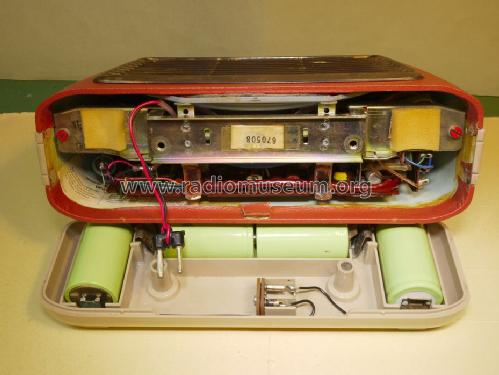Weekend T10 Type 41082
Schaub und Schaub-Lorenz
- Country
- Germany
- Manufacturer / Brand
- Schaub und Schaub-Lorenz
- Year
- 1960–1962
- Category
- Broadcast Receiver - or past WW2 Tuner
- Radiomuseum.org ID
- 5989
Click on the schematic thumbnail to request the schematic as a free document.
- Number of Transistors
- 7
- Main principle
- Superheterodyne (common); ZF/IF 460 kHz
- Tuned circuits
- 7 AM circuit(s)
- Wave bands
- Broadcast, Long Wave and Short Wave.
- Power type and voltage
- Dry Batteries / D: 4 x 1.5 Volt
- Loudspeaker
- Permanent Magnet Dynamic (PDyn) Loudspeaker (moving coil) - elliptical
- Power out
- 0.7 W (unknown quality)
- Material
- Plastics (no bakelite or catalin)
- from Radiomuseum.org
- Model: Weekend T10 Type 41082 - Schaub und Schaub-Lorenz
- Shape
- Portable set > 8 inch (also usable without mains)
- Dimensions (WHD)
- 270 x 177 x 93 mm / 10.6 x 7 x 3.7 inch
- Notes
-
Gehäuse Pressstoff mit Kunstlederbezug in 3 Kombinationen,
lindgrün/sand, korallenrot/sand und einfarbig sand, mit
abnehmbarem, ledernem Trageriemen mit Sicherheitsverriegelung.
Three colour versions 41080/81/82.
Version 41082 has a "sand" case.Basisspannungs-Stabilisierung mit fest eingebauter DEAC-Zelle (NiCd-Akku).
- Net weight (2.2 lb = 1 kg)
- 5 lb (5 lb 0 oz) / 2.270 kg
- Price in first year of sale
- 195.00 DM
- Source of data
- HdB d.Rdf-& Ferns-GrH 1960/61 / Radiokatalog Band 1, Ernst Erb
- Mentioned in
- HdB d.Rdf-& Ferns-GrH 1961/62
- Other Models
-
Here you find 971 models, 830 with images and 690 with schematics for wireless sets etc. In French: TSF for Télégraphie sans fil.
All listed radios etc. from Schaub und Schaub-Lorenz
Collections
The model Weekend is part of the collections of the following members.
Forum contributions about this model: Schaub und Schaub-: Weekend T10 Type 41082
Threads: 1 | Posts: 1
Der Schaub-Lorenz Weekend T10 tut nichts, wenn er zu mir kommt. Drinnen steckt der DEAC-Stabilyt, dessen giftiger Inhalt vielleicht die Platine zerfressen hat. Ausserdem lauern OC169-Zinnfaser-Transistoren. Trotzdem gebe ich dem Radio Strom. Es nimmt etwa 30-40 mA auf, und der Oszillator läuft. Die DEAC-Zelle wird entfernt – die Platine ist Gottseidank fast ganz intakt. Der DEAC wird ersetzt durch die bekannte Ersatzschaltung. Der Stromverbrauch fällt auf etwa 10-20 mA. Irgendwann rauscht es kurzzeitig; danach Stille. Nach dem Austausch aller Koppel-Kondensatoren ist das Radio zu hören, aber die Wiedergabe ist schwach. Ausserdem fällt der Ton immer wieder aus. Der stückweise Ersatz der übrigen Elektrolyt-Kondensatoren macht den Ton immer lauter und immer besser. Ein paar Stellen am Gehäuse müssen geleimt werden, damit es keine Löcher mehr hat. Es ist jetzt wieder zusammengebaut, und es spielt für mich, auf Langwelle, Mittelwelle und auf Kurzwelle. Kurz einmal nachgerechnet: Das Radio ist heute etwa 60 Jahre alt – da darf es schon einmal einen Kondensatoren-Wechsel haben…
Attachments
Bruce Cohen, 11.Mar.19























